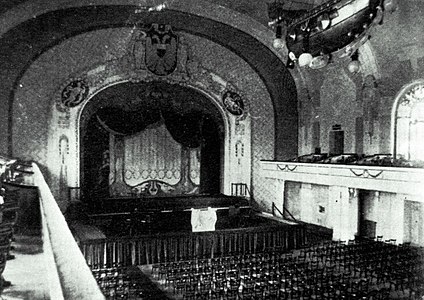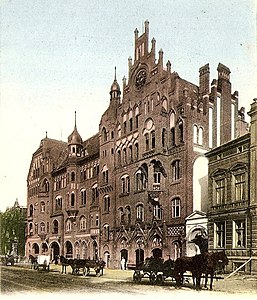City Hall (Lübeck)
The town hall is a Lübeck cinema and is currently the oldest recorded cinema in town.
City Hall Theater
From around 1899 the desire arose to create a large, modern hall with a capacity for around 2,000 people, such as the Mainz or Mannheim city halls. The architects Georg Runau ( Lübeck ) and Otto Kerwien ( Potsdam ) and others came up with a solution in 1899 for the site of the old Tivoli Gardens ( castle gate ) and in 1901 for the salt store ( Holsten Bridge ). Both were not realized.
Now a piece of land was found at the third entrance to the city, the location and shape of which should be decisive - the Concordia Garden. The project was started with a provisional capital of 800,000 marks, which the Verein für Musikfreunde recently increased by 500,000 marks, with the formation of a consortium of 12 people in January 1903 and was completed after less than 9 months ( shell construction ). According to the draft Kerwiens incumbent Runau the line on site.
- City Hall (1904)
The four-storey residential building rises 43 m to the street ( Mühlenbrücke 9-13 ). It contained ten apartments (today the business premises of Greater Union International GmbH), three shops, a passage to the garden and on the south side on the ground floor the restaurant and entrance vestibule for the party rooms. The fronts were built with Rathenow stones of medieval format in the sense of the North German brick Gothic. It took an elevator and two artificial sandstone stairs with wrought iron railings gilded led to the squares of the first rank . The main hall, with an area of 926 m², was 17th in size in Germany. The stage facade was crowned by the Lübeck eagle, which was flanked by two women (an attribute of acting and music).
The architecture of the festival rooms was, except for the lighting , in a modern stylized baroque style.
An architectural motif recurs several times. It is the representation of three vertical lines (see e.g. the garden view). They represent rod wells, the symbol of the architect. They are intended to indicate the divine trinity as the symbol of true divine art.
In addition to the festival rooms at the Krähenteich with a view of Lübeck, there is the 8,000 m² terraced garden that was used for concerts.
The stage was inaugurated with a guest performance, Lessing: “Minna von Barnhelm”, by the ensemble of the German Theater in Hamburg on Sunday, October 23rd. The Friends of Music Association gave a concert on Monday and a gala dinner in the restoration rooms concluded the celebrations on Thursday.
Lübeck had a new attraction .
- Drawing for the interior renovation in the town hall (1907)
In the following years, however, this turned out to be nowhere near as profitable as the planning once prophesied. The arrangement of the public rooms turned out to be not as practical as it was necessary for a profitable business. In addition, the large concert and theater hall was unsustainable due to its considerable acoustic deficiencies.
The town hall was rebuilt according to the plans of the architect Rudolph Wilken , according to whose plans the Hansa Theater was built.
The hall (sketch 1) had to be reduced in size for better acoustics . The cross-section shows that the barrel-like vaulted ceiling has been replaced by a ceiling that is just 13 m above the floor. The supporting pillars were brought up to the ceiling frieze. This reduced the width of the hall to 19.5 m and the length from 36 to 28 m (sketch 2).
Sketch 3 shows the floor plan of the converted hall on the ground floor . The seats in their new arrangement rise in rows away from the stage and from the center to the sides.
The floor plan of the first tier shows sketch 4. It was pushed up to the stage opening. Here, too, the back row was higher than the front row.
The ceiling was built into wood in a cassette division. This served to insulate and absorb the sound.
The doors to the foyer were replaced and the lighting was replaced by 4 arc lamps and light bulbs distributed in the cassettes .
Direct access to the restaurant was created from the theater exit. The garden was completely redesigned and provided with a walkway on the water.
In August 1915, the operator ran into financial difficulties; the town hall was taken over by the Hanseatic City of Lübeck. However, there was initially no concept for the long-term use of the building, which is extremely expensive to maintain. Even the conversion to an indoor swimming pool was considered. The lease to a theater company was ruled out because there was fear of competition for the city theater .
After the First World War
It was not until February 1919 that an acceptable tenant was found for the city of Lübeck: James Henschel GmbH , a subsidiary of Universum Film AG , which operated several cinemas in Hamburg and was also an important film distributor in northern Germany, took over the city hall as a cinema . In the lease, the city reserved the right to influence the cinema program and, as the owner of the building, received the right to use the city hall for its own events if necessary.
After the necessary renovations had been completed, the opening of the Stadthallen-Lichtspiele took place on September 19, 1919. With 1200 seats, it was the largest cinema in Lübeck. In contrast to the city's cinemas that existed until then, a visit to the town hall, which was perceived as more elegant and also controlled by the authorities, was from the start considered respectable entertainment and not as undemanding or disreputable diversion for the lower class.
In September 1929, Henschel decided not to extend the lease. His partner, the Hamburg businessman Wilhelm Markmann, needed new partners because of the costly conversion to sound film equipment and for the urgently needed renovation of the town hall. He won the Lübeck merchant Leopold Gonser and the music dealer Ernst Robert. Robert left the partnership after a few years, and Markmann only rarely appeared on business, so that the management of the theater was solely with Gonser in the following decades.
With the newly acquired capital, the Stadthallen-Lichtspiele were converted into a sound film cinema in 1930. In 1934 a comprehensive modernization followed, whereby the rich stucco decorations and decorations, which were now perceived as old-fashioned and which came from the time of the original use as a theater, were removed. In addition to a more contemporary appearance, it was hoped that this would improve the still unsatisfactory acoustics , but this did not materialize.
In 1938, in view of the competition from the Delta-Palast , the Stadthallen-Lichtspiele were closely linked to Universum Film AG as a so-called director's theater , as this was the only way to preserve the group's high-profile productions, which are indispensable for a cinema of this size were. The town hall was contractually obliged to surrender 8% of the box office results to Ufa and in return received more favorable rental conditions than independent movie theaters. Thanks to the preferential treatment given by the Ufa Group, the city hall became Lübeck's leading cinema again.
World War II and post-war period
The British bombing of 28/29. March 1942 , which destroyed large parts of Lübeck's historic old town, also hit the town hall. The cinema was destroyed, while the front part of the building with the foyer suffered only relatively minor damage. The entrance hall and foyer were converted into a makeshift hall; In the same year, the cinema was reopened as the city hall emergency light play theater with 400 seats.
After the occupation of Lübeck by British armed forces on May 2, 1945, the town hall was confiscated and served as a Victory Cinema exclusively for British soldiers and their families. In 1947 it was returned to Leopold Gonser and the operating license was granted as an independent cinema.
In 1951 the construction of a new hall began, supported by funds earmarked by the state of Schleswig-Holstein for the repair of war damage. In accordance with the interests of the city of Lübeck, which was still the owner of the town hall, a building was primarily designed as a modern congress and concert hall with 1011 seats, the actual main use of which as a cinema required numerous compromises. The content of the new lease with Gonser was almost identical to the one signed with Henschel in 1919. The city secured the right to use the city hall for 10 congresses, 18 cultural events and any number of other major events as required.
The dual use of the town hall turned out to be problematic in the following years, as the acoustics of the compromise building were not ideal for concerts or film screenings. It was almost never used for congresses.
After Leopold Gonser's death in December 1953, his daughter Barbara and her husband Kurt Bovensiepen took over the management of the Stadthallen-Lichtspiele, which was complicated by the necessary consideration of the city's event requests and the unfavorable conditions that independent cinemas received from film distributors compared to cinema chains . When at the beginning of the 1960s, due to the increasing spread of television, among other things, the number of viewers in the cinemas decreased, it was not possible to reduce the size of the cinema due to the double use, and a more carefully selected film program could not be implemented, as the large hall was used to cover costs Screening of mainstream films with corresponding occupancy made necessary.
In April 1973, Barbara Bovensiepen handed over the Stadthallen-Lichtspiele to the cinema operators Albert Kieft and Wilhelm Grießhammer as the new tenants, who continued to operate the cinema in the following decades despite its declining attractiveness and decreasing popularity with the Lübeck cinema audience. In 1991 asbestos was discovered in the cinema, which was built in 1951, which made it impossible to continue cinema operations. The Stadthallen-Lichtspiele were then closed.
Sale and renovation in 1994
In 1992, the Kieft Group, now based in Lübeck, acquired the town hall from the Hanseatic city of Lübeck. The asbestos-contaminated cinema was completely gutted in the following two years. After completion of this work, a cinema system with seven halls of various sizes and a total of 1570 seats was built as part of a complete modernization. The converted city hall, now under the name CineStar Filmpalast Stadthalle , was reopened in 1994 and has been the oldest operating theater in Lübeck since the Capitol closed in spring 2006.
See also
literature
- Petra Schaper: Cinemas in Lübeck . Verlag Graphische Werkstätten GmbH, Lübeck 1987, ISBN 3-925402-35-7
- City Papers ; Lübeck, October 30, 1904, article: The new building of the town hall
- City Papers ; Lübeck, April 14, 1907, article: The renovation of the town hall
Web links
Coordinates: 53 ° 51 ′ 37.6 ″ N , 10 ° 41 ′ 25.1 ″ E










